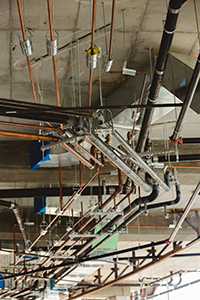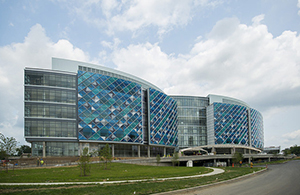Copper Piping Better Choice for Hospital Expansion
 WILMINGTON, Del. — Opening in October, the $215 million Nemours/A.I. DuPont Children’s Hospital expansion is a five-story contemporary facility that features a long list of patient and caregiver amenities. With 450,000 square feet, the five-story building boosts the hospital’s bed count from 200 to 260 and increases the emergency department from 29 to 44 bays.
WILMINGTON, Del. — Opening in October, the $215 million Nemours/A.I. DuPont Children’s Hospital expansion is a five-story contemporary facility that features a long list of patient and caregiver amenities. With 450,000 square feet, the five-story building boosts the hospital’s bed count from 200 to 260 and increases the emergency department from 29 to 44 bays.
The hospital celebrated the placement of the final steel beam for the expansion in June 2013, but when it came time to install the plumbing and mechanical system, the semi-circular shape created unforeseen challenges for the contractor. Originally, the building required a large-diameter piping system that was lightweight, malleable and easy to work with. Black steel pipe, which was originally going to be installed, was proving to be difficult for the project. That’s when Piscataway, N.J.-based Binsky & Snyder Mechanical Contractors; Parsippany, N.J.-based SkanskaUSA; and AEI Engineers, based in Madison, Wis., decided to reach out to the Copper Development Association (CDA).
Headquartered in New York, CDA recommended copper piping due to its durability, versatility and resistance to corrosion, as well as its ease for bending and fabrication.
“We received a call from the engineer on the project asking about bending copper tube in sizes up to 2.5 and 3 inches so that they could have it wrap around two football-shaped additions,” said Dale Powell, project manager and piping application specialist for CDA. “Following discussions with the engineer and installing mechanical contractor, it was determined that the amount of bend required would be well within the limits for copper tube and could easily be accomplished by several local pipe bending companies.”
Various-sized copper tubing is being installed for domestic hot- and cold-water service, HVAC systems and medical gas distribution.
 Using modular construction techniques, including mechanically formed extruded outlets that effectively reduce the number of tee fittings and soldered or brazed joints needed, CDA assisted the engineering team in creating curved copper tube assemblies to meet the project’s design and ensure its functionality. As a result, the entire large-diameter piping work will be done using copper.
Using modular construction techniques, including mechanically formed extruded outlets that effectively reduce the number of tee fittings and soldered or brazed joints needed, CDA assisted the engineering team in creating curved copper tube assemblies to meet the project’s design and ensure its functionality. As a result, the entire large-diameter piping work will be done using copper.
Michael Duffy, project manager for Binsky & Snyder, said that by applying this type of joining technique, crews were able to work faster and more efficiently, providing a much better installation at a lower system cost, even though the material prices were higher.
“Given the radius of the building, the bending required and the weight of the piping, it was much easier for us to work with copper than steel pipe,” Duffy said.
The project design team was also able to pre-fabricate the plumbing modules for the bathrooms and medical gas system offsite in a warehouse 10 miles away. Using a series of rack systems, the piping was transported to the site, once it was ready to be installed.
When complete, the hospital expansion will consist of a 144-bed unit with underground parking. The parking garage will also connect to the existing building by means of a three-story connecting link. The building’s first floor will contain a new emergency department, atrium, retail and dining facility.
